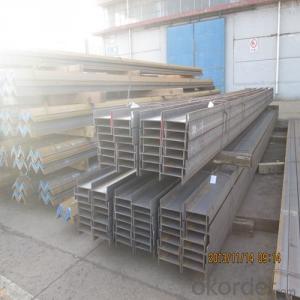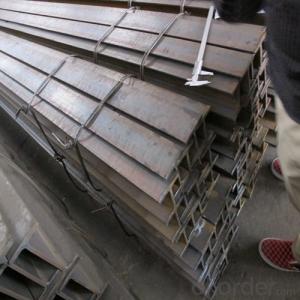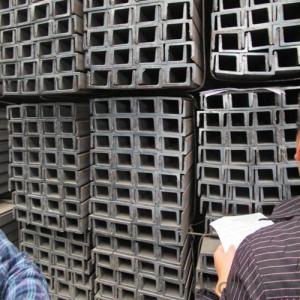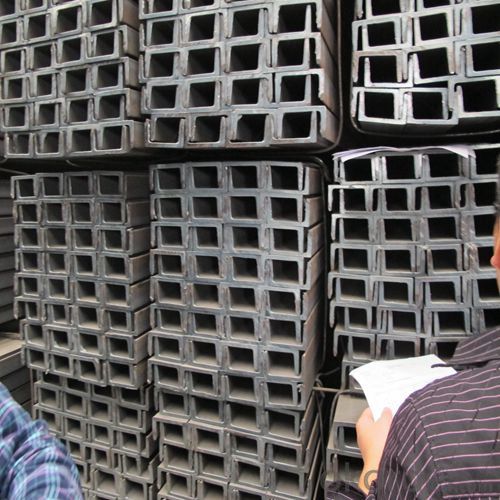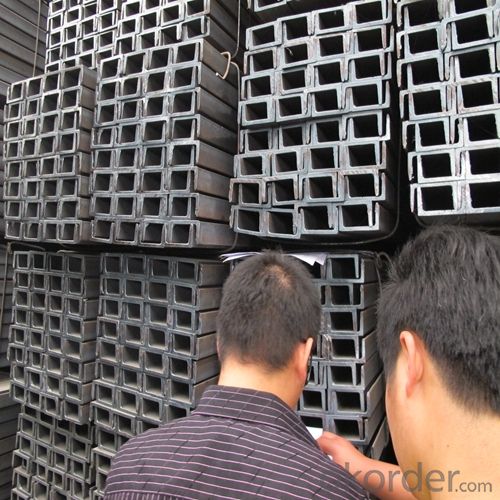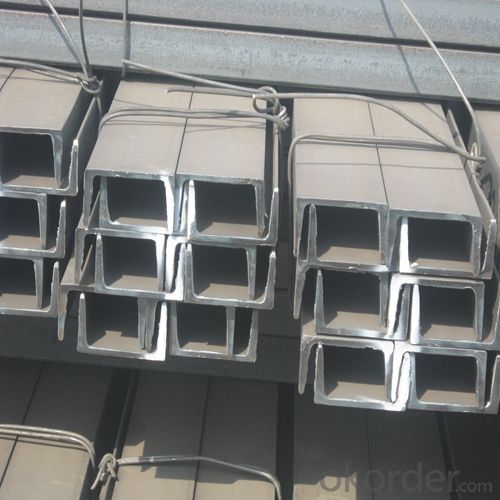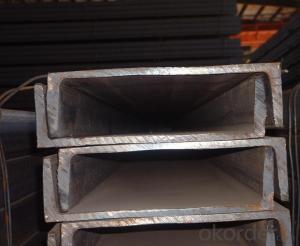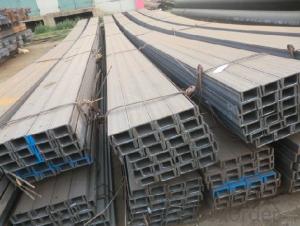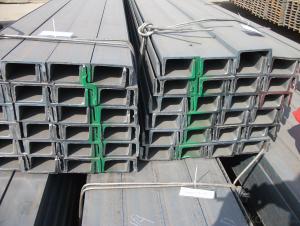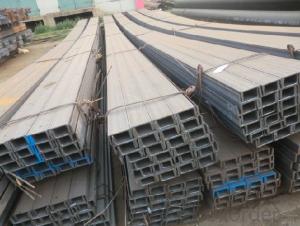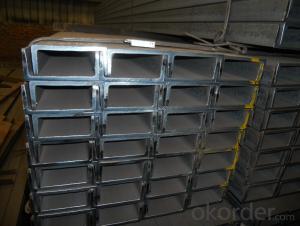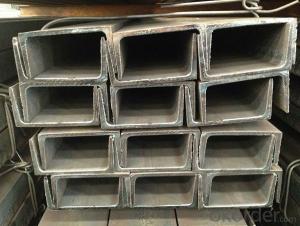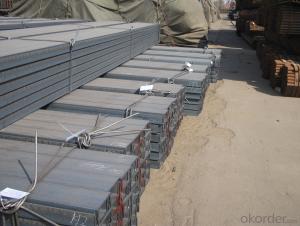Hot Rolled Structure Steel U-Channel JIS Standard GB Standard With Good Price
- Loading Port:
- Tianjin
- Payment Terms:
- TT OR LC
- Min Order Qty:
- 200 m.t.
- Supply Capability:
- 30000 m.t./month
OKorder Service Pledge
OKorder Financial Service
You Might Also Like
Product Description:
Product Description:
OKorder is offering high quality Channel Steel at great prices with worldwide shipping. Our supplier is a world-class manufacturer of steel, with our products utilized the world over. OKorder annually supplies products to European, North American and Asian markets. We provide quotations within 24 hours of receiving an inquiry and guarantee competitive prices.
Product Applications:
Channel Steel is usually used for building structure, vehicle manufacturing and other industrial structure and often used with i beam.
In details, the channel steel belongs to carbon structural steel which is applied to in the field of construction and machinery. The channel steel is usually used for arch-itechtural structure, and they could be welded in order to support or hang a vari-ety of facilities. They are also usually used in combination with I beam. Generally,the channel steel must possess perfect welding property, riveting property and mechanical property and so on.
Product Advantages:
OKorder's Channel Steel are durable, strong, and resist corrosion.
Main Product Features:
· Premium quality
· Prompt delivery & seaworthy packing (30 days after receiving deposit)
· Corrosion resistance
· Can be recycled and reused
· Mill test certification
· Professional Service
· Competitive pricing
2. The detailed sections of MS Channel as per GB standard.are shown in the table-1:
GB U CHANNEL | Standard | Sectional | Dimension |
| Mass: |
(mm) | (mm) | (mm) | (mm) | ||
50X37 | 50 | 37 | 4.50 | 7.0 | 5.438 |
63X40 | 63 | 40 | 4.80 | 7.5 | 6.634 |
80x43 | 80 | 43 | 5.00 | 8.0 | 8.045 |
100x48 | 100 | 48 | 5.30 | 8.5 | 10.007 |
120x53 | 120 | 53 | 5.50 | 9.0 | 12.059 |
140x58 | 140 | 58 | 6.00 | 9.5 | 14.535 |
140x60 | 140 | 60 | 8.00 | 9.5 | 16.733 |
160x63 | 160 | 63 | 6.50 | 10.0 | 17.240 |
160x65 | 160 | 65 | 8.50 | 10.0 | 19.752 |
180x68 | 180 | 68 | 7.00 | 10.5 | 20.174 |
180x70 | 180 | 70 | 9.00 | 10.5 | 23.000 |
200x73 | 200 | 73 | 7.00 | 11.0 | 22.637 |
200x75 | 200 | 75 | 9.00 | 11.0 | 25.777 |
220x77 | 220 | 77 | 7.00 | 11.5 | 24.999 |
220x79 | 220 | 79 | 9.00 | 11.5 | 28.453 |
250x78 | 250 | 78 | 7.00 | 12.0 | 27.410 |
250x80 | 250 | 80 | 9.00 | 12.0 | 31.335 |
250x82 | 250 | 82 | 11.00 | 12.0 | 35.260 |
280x82 | 280 | 82 | 7.50 | 12.5 | 31.427 |
280x84 | 280 | 84 | 9.50 | 12.5 | 35.823 |
280x86 | 280 | 86 | 11.50 | 12.5 | 40.219 |
300x85 | 300 | 85 | 7.50 | 13.5 | 34.463 |
300x87 | 300 | 87 | 9.50 | 13.5 | 39.173 |
300x89 | 300 | 89 | 11.50 | 13.5 | 43.883 |
Table-1
3. The chemical composition of HR Channel Steel according to Q235B is shown in Table-2.
Alloy No | Grade | Element(%) | ||||
C | Mn | S | P | Si | ||
Q235 | B | 0.12-0.20 | 0.3-0.7 | ≦0.045 | ≦0.045 | ≦0.3 |
Table-2
Note: we are able to present our customers relevant SGS test report for chemical composition of HR Channel Steel.
4. The mechanical property of HR Channel Steel according to Q235B is shown in Table-3-1 and Table-3-2
Alloy No | Grade | Yielding Strength Point(Mpa) | |||
Thickness(mm) | |||||
≦16 | >16-40 | >40-60 | >60-100 | ||
≧ | |||||
Q235 | B | 235 | 225 | 215 | 205 |
Table-3-1
Alloy No | Grade | Tensile Strength(Mpa) | Elongation After Fracture(%) | |||
Thickness(mm) | ||||||
≦16 | >16-40 | >40-60 | >60-100 | |||
≧ | ||||||
G235 | B | 375-500 | 26 | 25 | 24 | 23 |
Table-3-2
Note: we are able to present our customers relevant SGS test report for mechanical property of MS Channel as customer’s request.
Usage/Applications of Channel Steel:
Channel Steel is usually used for building structure, vehicle manufacturing and other industrial structure and often used with i beam.
In details, the channel steel belongs to carbon structural steel which is applied to in the field of construction and machinery. The channel steel is usually used for arch-itechtural structure, and they could be welded in order to support or hang a vari-ety of facilities. They are also usually used in combination with I beam. Generally,the channel steel must possess perfect welding property, riveting property and mechanical property and so on.
Package & Delivery of Channel Steel:
The steel u channel will be packed in bundle with steel wire at each end of every bundle and color marking in order to help the customer to recognize his goods more easily at sight.
And steel u channel could be loaded into 20ft or 40ft container, or by bulk cargo. If the weight of each bundle reaches less than 3.5 mt, the loading by break bulk cargo should be choosed. When the weight of each bundle reaches less than 3mt, the loading by container should be choosed.
As for the transportaion from mill to loading port, the truck will be usually used. And the maximum quantity for each truck is 40mt.
All in all, we could do in accordance with customer's request.
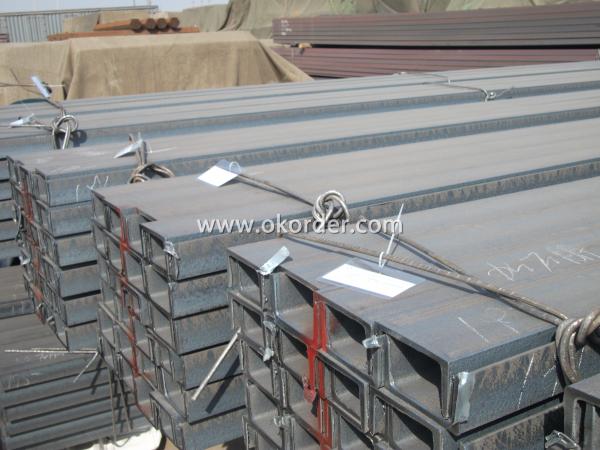
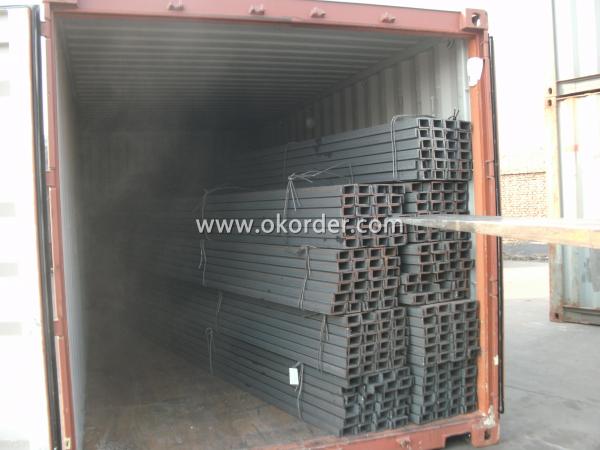
Production Flow of Channel Steel:
1.The steel billet shall be heated in the high temperature furnace.
2. The heated steel billet shall be rolled five to nine times with the aim of shaping the general figure of steel u channel.
3. The rolled steel u channel should be put onto the cooling bed to make the temperature low.
4. The steel u channel should be straighted on the straightener.
5. The straighted steel u channel will be cut into meters by saw, as per customer's requirements.
- Q: How do steel channels compare to other materials like wood or aluminum?
- Steel channels outperform other materials such as wood or aluminum in several ways. To begin with, steel channels are renowned for their exceptional strength and durability. They can withstand heavy loads without damage or deformation, making them ideal for industries like construction or manufacturing that demand structural integrity and stability. In contrast, wood channels have limited weight-bearing capacity and are prone to rot, warping, and termite infestation. Meanwhile, aluminum channels may not possess the same level of strength as steel, rendering them unsuitable for heavy-duty applications. Furthermore, steel channels provide excellent fire resistance. Unlike wood, which is combustible, steel channels do not contribute to the propagation of fire. Consequently, they are a safer choice in settings where fire safety is a concern, such as commercial buildings or industrial facilities. Another advantage of steel channels is their low maintenance requirements. Steel is resistant to corrosion, rust, and decay, eliminating the need for regular treatment or painting to maintain structural integrity. Conversely, wood channels necessitate periodic staining, sealing, or repainting to prevent deterioration, while aluminum channels may require coating or anodizing to guard against corrosion. Moreover, steel channels are readily available and cost-effective. Given the widespread use of steel in various industries, steel channels are easily accessible. Additionally, the production of steel channels is efficient and cost-effective, making them a more affordable option when compared to materials like wood or aluminum. However, it is important to acknowledge that each material possesses its own unique properties and advantages. For instance, wood offers a natural and aesthetic appeal that cannot be replicated by steel. On the other hand, aluminum is lightweight and boasts good thermal conductivity, making it suitable for specific applications. In conclusion, steel channels excel in terms of strength, durability, fire resistance, low maintenance requirements, and cost-effectiveness when compared to materials like wood or aluminum. They are particularly well-suited for applications that demand strength, longevity, and fire safety.
- Q: Does anyone know how to calculate the volume of channel steel?!
- Theoretical calculations can be used: sectional area * length. There are sectional sizes in the specifications of channel steel labels. The sectional area and volume shall be calculated first. When measuring the sectional area, the grid paper can be used. Of course, the accuracy is limited.
- Q: What are the common fastening methods for steel channels?
- The common fastening methods for steel channels include using bolts and nuts, welding, and using self-tapping screws.
- Q: What type of channel steel and I-beam should be used to build an attic floor? Thank you!
- When the channel is fixed, the expansion bolt is used to see what the wall is. The casting can be expanded directly on the wall or fixed by the chemical bolts, and the brick wall needs slotting.
- Q: How do you calculate the weight of 100 channel steel?
- If it is GB, the channel can be checked by the hardware manual sheet, and the weight is multiplied by the length of each meter, that is, its weight.
- Q: How do steel channels resist corrosion?
- Steel channels resist corrosion due to the protective layer formed by the oxidation of iron when exposed to oxygen and moisture in the air. Additionally, steel channels can be galvanized or coated with a corrosion-resistant material, further enhancing their resistance to corrosion.
- Q: Can steel channels be used in the construction of retaining walls?
- Yes, steel channels can be used in the construction of retaining walls. Steel channels are often used as structural components in various construction projects due to their durability and strength. When used in retaining walls, steel channels can provide additional reinforcement and stability to the structure. They can be embedded into the ground as vertical or horizontal supports, helping to distribute the load and prevent soil erosion. Steel channels are also resistant to weathering and corrosion, making them suitable for long-term use in retaining walls. However, it is important to consider the specific design requirements and consult with a structural engineer to ensure the appropriate size, spacing, and placement of steel channels for the specific retaining wall project.
- Q: Are steel channels suitable for gymnasium structures?
- Indeed, gymnasium structures find steel channels to be an appropriate choice. Owing to their resilience, potency, and adaptability, steel channels are widely employed in construction. Their ability to bear substantial weight and offer stability makes them an excellent fit for gymnasiums. Moreover, the ease with which steel channels can be fabricated and installed renders them a cost-efficient selection for gymnasium construction. Furthermore, the remarkable fire, corrosion, and pest resistance of steel channels guarantee the endurance of gymnasium structures. Ultimately, steel channels emerge as a trustworthy and pragmatic alternative for the construction of gymnasiums.
- Q: How do steel channels compare to other structural shapes like beams and angles?
- Due to their strength, versatility, and cost-effectiveness, steel channels, beams, and angles find widespread use in construction and structural engineering. Each of these structural shapes possesses unique characteristics and applications, rendering them suitable for various purposes. When comparing steel channels to beams and angles, it becomes crucial to take into account their load-bearing capacity, structural stability, and overall performance. Steel channels, also known as C-channels or U-channels, exhibit a distinctive shape characterized by a vertical web connecting flat top and bottom flanges. They are commonly employed in applications necessitating lightweight structural support, such as framing, bracing, or object securing. Steel channels excel in evenly distributing loads and providing sufficient support in multiple directions. Their versatility allows for seamless integration into diverse structural designs. On the other hand, beams typically possess an I-shape and offer superior load-bearing capabilities compared to channels. Their design enables them to handle higher loads across longer spans. Beams typically serve as primary structural elements in buildings, bridges, and other large-scale constructions. Thanks to their high strength-to-weight ratio, beams are ideal for withstanding bending and flexural stresses. Angles, comprising two perpendicular legs of equal or unequal lengths, manifest as L-shaped structural components. They primarily serve the purpose of providing additional structural support and reinforcement. Angles commonly find use as braces, corner supports, or lintels. Their versatility allows for easy connections and integration within a structure. In terms of cost, steel channels are generally more affordable compared to beams and angles due to their simpler manufacturing process and lower material requirements. However, the cost may vary depending on the specific dimensions, grades, and finishes required. Overall, the choice between steel channels, beams, or angles depends on the specific application, load requirements, span lengths, and design constraints. It is crucial to consult with a structural engineer or designer to determine the most suitable structural shape for a particular project.
- Q: Are steel channels suitable for outdoor applications?
- Indeed, steel channels are well-suited for outdoor applications. Due to their endurance and potency, steel channels are commonly employed in outdoor construction ventures. They have the ability to endure severe weather conditions, including rain, wind, and extreme temperatures. Moreover, steel channels possess resistance against rust and corrosion, rendering them highly suitable for outdoor settings where they may encounter moisture or water. Furthermore, steel channels provide exceptional structural support, making them appropriate for a variety of outdoor applications, such as bridges, buildings, fences, and outdoor equipment. In summary, steel channels are a dependable and adaptable option for outdoor projects due to their sturdiness and ability to withstand environmental elements.
Send your message to us
Hot Rolled Structure Steel U-Channel JIS Standard GB Standard With Good Price
- Loading Port:
- Tianjin
- Payment Terms:
- TT OR LC
- Min Order Qty:
- 200 m.t.
- Supply Capability:
- 30000 m.t./month
OKorder Service Pledge
OKorder Financial Service
Similar products
Hot products
Hot Searches
Related keywords
